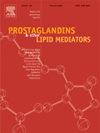The interplay of LDLR, PCSK9, and lncRNA- LASER genes expression in coronary artery disease: Implications for therapeutic interventions
IF 2.5
3区 生物学
Q3 BIOCHEMISTRY & MOLECULAR BIOLOGY
Prostaglandins & other lipid mediators
Pub Date : 2025-03-01
DOI:10.1016/j.prostaglandins.2025.106969
引用次数: 0
Abstract
Background and purpose
Coronary artery disease (CAD) is defined as stenosis of coronary arteries due to atherosclerosis. The etiology of atherosclerosis can be attributed to a disruption in lipid metabolism, specifically cholesterol and low-density lipoprotein cholesterol (LDL-C). PCSK9 is an enzyme that controls the metabolism of LDL-C by degrading the low-density lipoprotein receptor (LDLR), which in turn affects the metabolism of LDL-C. A newly discovered Long Non-coding RNA named LASER, which affects the homeostasis of cholesterol, has been identified through the evaluation of bioinformatics. The objective of this study was to assess the levels of gene expression related to cholesterol balance, specifically LDLR, PCSK9, and LASER, in peripheral blood mononuclear cells (PBMCs) of Iranian CAD patients in comparison to controls.
Experimental approach
This case-control study included 49 CAD patients, with 81.63 % receiving statins, compared to 40 control subjects, of whom 40 % received statins. The qRT-PCR was used to analyze the expression levels of LDLR, PCSK9, and LASER in PBMCs. Additionally, the ELISA method was employed to determine the blood concentration of PCSK9.
Findings / results
CAD patients demonstrated a significant reduction in PBMC gene expression levels of LDLR (P < 0.01) and a significant rise in gene expression of PCSK9 and LASER, as well as blood concentration of PCSK9 (P < 0.05) compared to controls. The gene expression of PCSK9 showed a strong positive relationship with LDLR expression in patients (P = 0.0003). Furthermore, a strong correlation was seen between PCSK9 and LASER, as well as LASER and LDLR expression (P < 0.0001) in two groups.
Conclusion and implications
PCSK9 and LASER are potential therapeutic targets for atherosclerosis-related disorders, including CAD. Given that patients receiving statins were twice that of the control subjects, and the effect of statins on the LDLR, PCSK9 and LASER, further research is required to delineate the distinct effects of coronary artery disease conditions and statin usage on the expression of the aforementioned genes.
冠状动脉疾病中 LDLR、PCSK9 和 lncRNA- LASER 基因表达的相互作用:对治疗干预的影响。
背景与目的:冠状动脉疾病(CAD)是指由动脉粥样硬化引起的冠状动脉狭窄。动脉粥样硬化的病因可归因于脂质代谢的破坏,特别是胆固醇和低密度脂蛋白胆固醇(LDL-C)。PCSK9是一种通过降解低密度脂蛋白受体(LDLR)来控制LDL-C代谢的酶,LDLR反过来影响LDL-C的代谢。通过生物信息学评价,新发现了一种影响胆固醇稳态的长链非编码RNA LASER。本研究的目的是评估伊朗CAD患者外周血单个核细胞(PBMCs)中与胆固醇平衡相关的基因表达水平,特别是LDLR、PCSK9和LASER。实验方法:本病例对照研究纳入49例CAD患者,其中81.63%接受他汀类药物治疗,对照组40例,其中40%接受他汀类药物治疗。采用qRT-PCR分析pbmc中LDLR、PCSK9和LASER的表达水平。采用ELISA法测定PCSK9血药浓度。结果:与对照组相比,患者LDLR中PBMC基因表达水平显著降低(P < 0.01), PCSK9、LASER基因表达及PCSK9血药浓度显著升高(P < 0.05)。PCSK9基因表达与患者LDLR表达呈显著正相关(P = 0.0003)。在两组中,PCSK9与LASER、LASER与LDLR的表达有较强的相关性(P < 0.0001)。结论和意义:PCSK9和LASER是动脉粥样硬化相关疾病(包括CAD)的潜在治疗靶点。考虑到接受他汀类药物治疗的患者是对照组的两倍,以及他汀类药物对LDLR、PCSK9和LASER的影响,需要进一步的研究来描述冠状动脉疾病状况和他汀类药物使用对上述基因表达的明显影响。
本文章由计算机程序翻译,如有差异,请以英文原文为准。
求助全文
约1分钟内获得全文
求助全文
来源期刊

Prostaglandins & other lipid mediators
生物-生化与分子生物学
CiteScore
5.80
自引率
3.40%
发文量
49
审稿时长
2 months
期刊介绍:
Prostaglandins & Other Lipid Mediators is the original and foremost journal dealing with prostaglandins and related lipid mediator substances. It includes basic and clinical studies related to the pharmacology, physiology, pathology and biochemistry of lipid mediators.
Prostaglandins & Other Lipid Mediators invites reports of original research, mini-reviews, reviews, and methods articles in the basic and clinical aspects of all areas of lipid mediator research: cell biology, developmental biology, genetics, molecular biology, chemistry, biochemistry, physiology, pharmacology, endocrinology, biology, the medical sciences, and epidemiology.
Prostaglandins & Other Lipid Mediators also accepts proposals for special issue topics. The Editors will make every effort to advise authors of the decision on the submitted manuscript within 3-4 weeks of receipt.
 求助内容:
求助内容: 应助结果提醒方式:
应助结果提醒方式:


